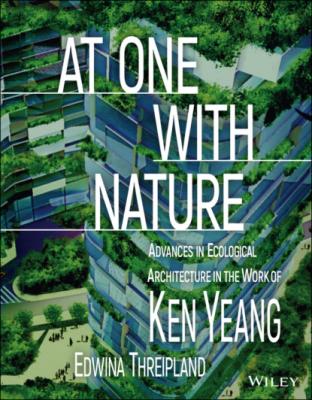ТОП просматриваемых книг сайта:
At One with Nature. Ken Yeang
Читать онлайн.Название At One with Nature
Год выпуска 0
isbn 9781119527879
Автор произведения Ken Yeang
Жанр Архитектура
Издательство John Wiley & Sons Limited
vegetated sky-courts
Interconnected buildings
Buildings on pilotis
to let vegetation and
air go through
Public plaza with
louvred canopies
Entertainment and play plazas
Smart cities sytem
Photovoltaic roof over
covered walkway
Ecological fingers
Hybrid constructed
ecosystems
© Ken Yeang
Foreword
Form, in the world of design, is discussed as style, shape, geometry, or reduced to a question
of functionality. But form, really, is a structure of relationships. This structure, made manifest, is the
configuration of pathways and nodes, thresholds, and edge conditions that regulate flow and exchange.
Every designed entity 'building or neighbourhood' is a spatial structure that dictates where people move,
where they pause, and what they do. There might be a parallel structure for how non-human species
do the same. Overlaid onto this are pathways for abiotic flows of energy, water, materials in the built
environment. Flows inside connect to flows outside, beyond boundaries of shell and site.
Ken Yeang, arguably, is one of few architects to link climate and now ecology explicitly to the
morphology of form and its underlying systemic structure. Yeang's bioclimatic model of the 1980s and
more recently his ecological model have re-imagined the arrangement of parts: ‘space, skin, tectonics,
environmental systems, and geographical siting’, and re-articulated the whole in service of multiple
ecological outcomes.
His early work on bioclimatic design was in part feature-based (sunshades, sky-courts, greenery)
and in part rule-based (geometry, orientation, local climatic factors), aimed at creating comfort and
reducing energy demand. Passive design had become marginalised in the 1970s and 1980s when the
ubiquitous skyscraper, sheathed in airtight skin and projecting an appearance of modernity, could be built
in any city, any climate. It was getting harder to make a case for permeable façades that would let in the
wind and light. Yeang's bioclimatic skyscraper attempted this and, in the process, offered a counterpoint
to the International Style. Spatially, the plan had passive- and climate-controlled spaces side by side;
in some spaces, occupants could toggle between the two. Parts of the building were surrendered to
semi-outdoor sky courts that formed an edge condition; service cores became thermal buffers to the
East–West sun; the plan and section were intersected with pathways for natural air movement; and the
facade was an arrangement of recesses and protuberances that mediated between indoor and outdoor.
These factors and features became emblems in Yeang's work in the 1980s and 1990s.
Yeang's current approach to the ecology of buildings came later and brought to this vocabulary
several emerging strands of science: ecosystem services (mimicry of nature's processes), ecosystem
habitats (greenery as pathway and patch), design metabolism (waste management and recycling), and
x FOREWORD
FOREWORD xi
biophilic design (human well-being). The edge was no longer indoor vs outdoor; it was human-built
systems interfacing with natural ecosystems. He argued for a synthesis of organic with the inorganic,
what he calls ‘biointegration’. Ecology, once confined to the ground, would be drawn up into built systems
to becoming part of the fabric of architecture.
In both his bioclimatic and ecological models, Yeang makes a case for ‘aesthetic exploration’, the
expression of elements and processes that he says are necessary to fulfil the aesthetic and biophilic
needs of users. The design vocabulary would articulate what elements do and how they connect with
each other. Form would shape performance and offer a perspective on beauty.
In his earlier book, Constructed Ecosystems, Yeang explains biointegration as the union of space,
technology, and surface, seeking new form-patterns. An eco-cell, for instance, cleans water and draws
air and light vertically through a building; the linked green wall is a planted facade, made continuous, to
enhance habitat formation and species movement. In one of his built examples, the Solaris (2011), a
17-storey office building in Singapore, a diagonal light-shaft cuts through the building's mass; multiple-
stepped landscape decks are connected to a 1.5 km spiral garden, through an eco-cell. No biodiversity
audit has been carried out, but there are anecdotal sightings of squirrels, snakes, and hornbills .
Yeang's goal is to restore the broken link between human and natural systems. Biointegration
makes architecture a ‘prosthetic’ to nature. This aligns Yeang with the eco-modernists who speak of the
hybridisation of the natural and human-made. His projects, even where they do not reach full potential,
are prototypes, he says, to refine ideas that ‘for the potency of what they promise’ challenge the design
profession at a time when the restoration of natural systems has a newly found urgency.
Nirmal Kishnani (Dr.)
Associate Professor, School of Design and Environment,
National University of Singapore
Excerpt from ‘Ecopuncture, Transforming Architecture and Urbanism in Asia’, a 2019 book by Nirmal Kishnani, published by BCI Asia
Construction Information Pte Ltd.
xii INTRODUCTION
Introduction
The publication of this book on ecological architecture comes at an unprecedented
time, as humanity’s impact on the environment has never been so significant. We sit
at a crossroads in our relationship with climate change. The UN Secretary-General
warned in 2018 that life on Earth faced a ‘direct existential threat’ if global warming
is not kept under 1.5°C, whilst the Members of Parliament in the United

